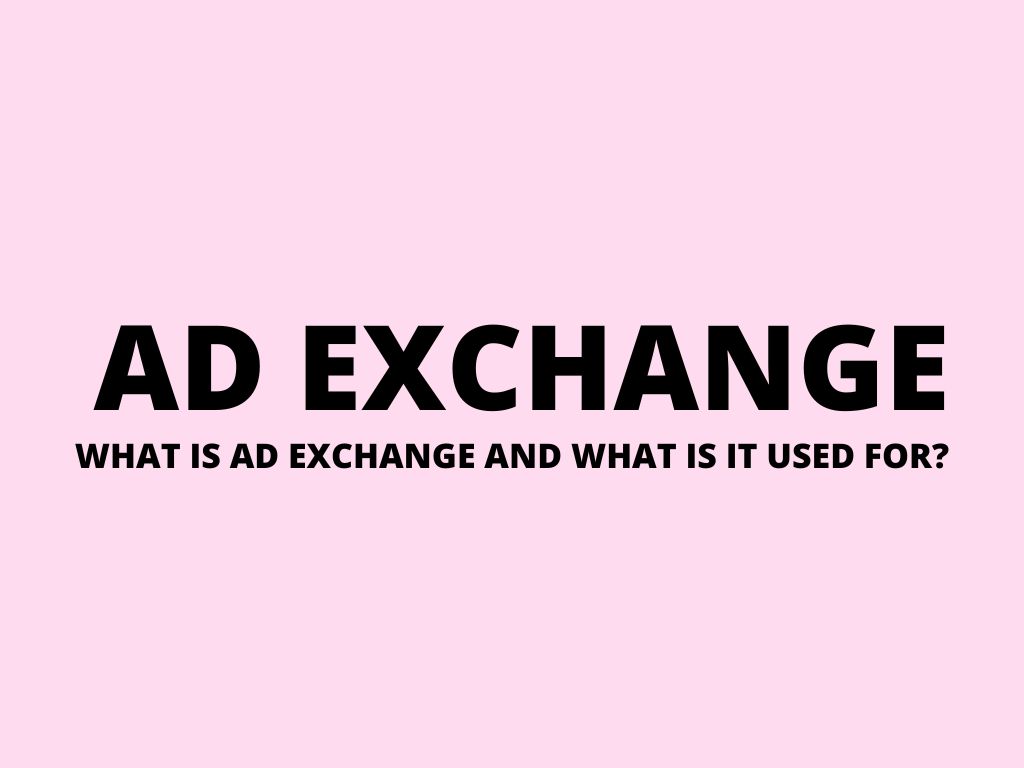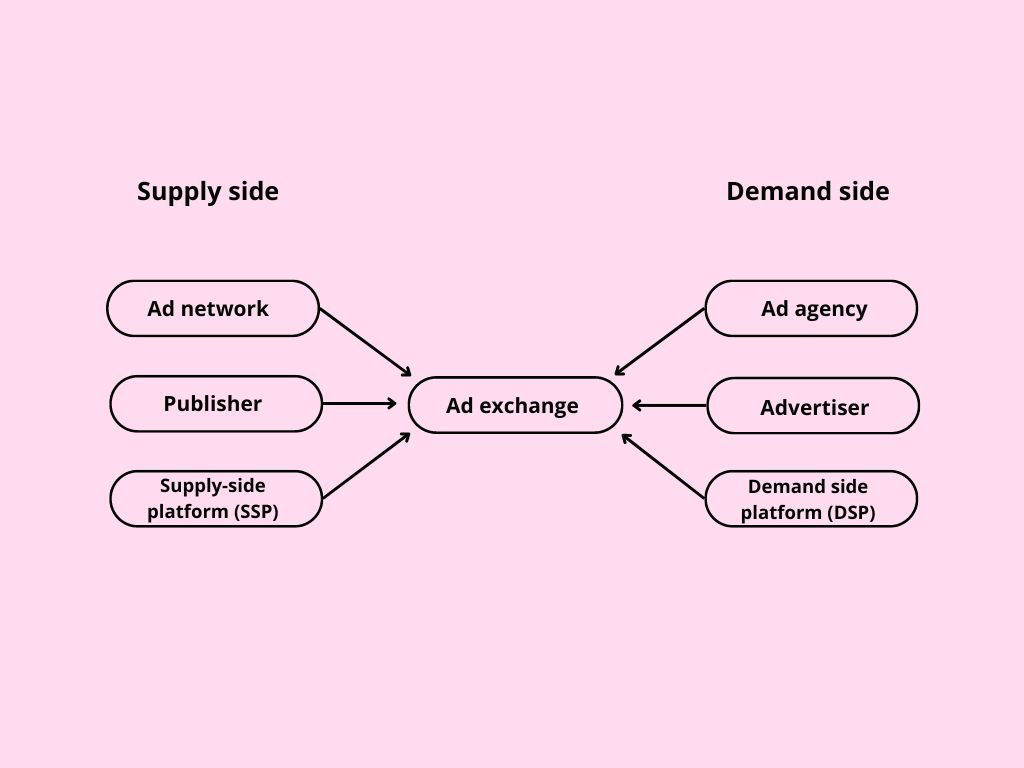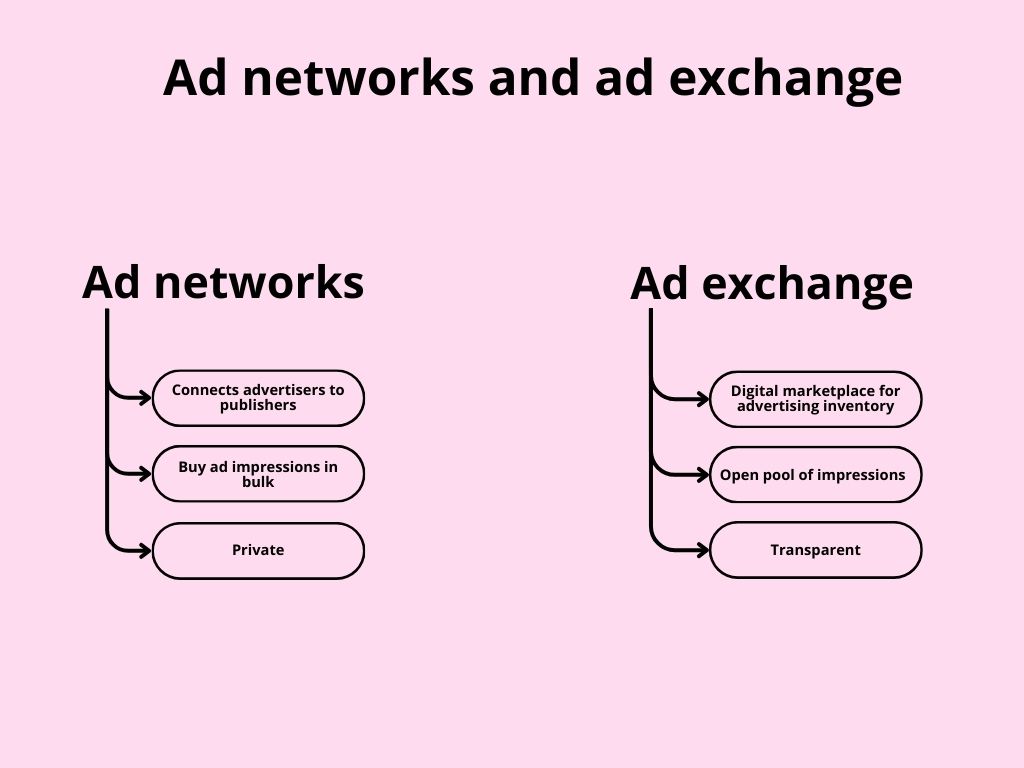
Ad exchange – what is ad exchange and what is it used for?
An ad exchange refers to a digital platform or marketplace where the buying and selling of advertising inventory take place.
What is an ad exchange?

An ad exchange is an online marketplace that facilitates the buying and selling of advertising inventory across various platforms, including websites, mobile sites, and mobile apps. Publishers, such as website or app owners, provide advertising space to advertisers, such as agencies or ad networks. This enables advertisers to purchase ad space and showcase display, video, and mobile ads.
Who uses ad exchange?
Ad exchanges are utilized by a wide range of individuals. Virtually anyone can participate in buying and selling impressions on an ad exchange. Publishers use ad exchanges to sell their available ad space, while advertisers or agencies utilize them to purchase ad space.
Why do marketers make use of ad exchanges? Marketers choose to use ad exchanges because they provide a more efficient and transparent method for buying and selling digital advertising. With the rapid growth and evolution of the mobile landscape, buyers and sellers have embraced ad exchanges to streamline processes and maximize profitability. The actual exchange of ads occurs through sophisticated algorithms, enabling publishers to obtain the best possible price for their ad inventory and allowing advertisers to reach their desired target audience with the right timing and contextual relevance.
Ad exchanges enable advertisers to easily purchase ads across a wide range of websites, mobile sites, and mobile apps simultaneously, eliminating the need for direct negotiations with individual publishers.
How do ad exchanges work?
To gain a deeper understanding of the role played by ad exchanges in the digital marketing ecosystem, let’s first examine the key participants and their interactions:
Ad networks – differentiating ad exchanges from ad networks

An ad network acts as a link between advertisers and publishers who possess advertising inventory. The primary function of an ad network involves gathering ad supply from publishers and matching it with the demand from advertisers.
Although ad exchanges and ad networks may appear to perform similar roles, they are distinct from each other. Ad networks acquire digital ad inventory from a list of publisher websites or purchase ad impressions in bulk from ad exchanges. They then sort and resell this inventory to advertisers. As advertisers often lack the time or resources to filter through available inventory, ad networks perform this task on their behalf.
Ad networks group inventory based on specific criteria such as pricing, scale, or audience segments (demographics, geography, language, interests, consumer behavior, etc.). Some ad networks prioritize broad coverage and quantity, while others specialize in offering high-quality ad slots.
Thus, while an ad exchange functions as an open pool of impressions, an ad network operates as a closed group of privately traded ads. In this sense, ad exchanges provide greater transparency to buyers as they can directly observe the exact prices at which each impression is being sold, without any intermediary players involved.
Terminology breakdown:
- Demand side platform (DSP) – a DSP is a technology that enables automated purchasing of advertising. It is commonly utilized by advertisers and agencies to facilitate the buying of display, video, mobile, and search ads.
- Supply side platform (SSP) – an SSP is a technology that enables automated selling of advertising. Online publishers primarily use SSPs to facilitate the selling of display, video, and mobile ads.
How does it all converge on the ad exchange?
In many ways, the functioning of an ad exchange resembles an auction, creating opportunities for advertisers to reach their target audiences across a vast array of publishers.
Advertisers and agencies typically connect to an ad exchange via a DSP, which allows them to participate in the buying process. On the other hand, publishers make their ad impressions available on the exchange by utilizing an SSP, enabling them to engage in the selling process.
The mechanics of real-time bidding (RTB)
Ad exchanges and the real-time bidding process When a user visits a web page or in-app screen, an ad impression is generated and put up for auction on the ad exchange. Using a DSP, advertisers can analyze data from various sources, such as the user’s mobile identifier, time of day, device type, ad position, demographics, and purchasing behavior, to determine whether they should bid on the impression and the optimal bid amount.
What makes this entire buying and selling process remarkable is its speed. Everything unfolds in an instant.
RTB relies on a fully automated procedure that calculates the price of advertising space and inventory in real-time, based on supply and demand dynamics. Advertisers can bid for ad space with a specific number of ad impressions, and ultimately, the ad belonging to the highest bidder is displayed for the impression.
Types of ad exchanges and prominent players Varieties of ad exchanges
-
Open ad exchange / Public Marketplace / Open Auction
This type of ad exchange operates as an open digital marketplace, offering a wide range of publishers’ inventory accessible to all advertisers. While open ad exchanges provide an extensive list of publishers, advertisers do not have detailed information about individual publishers, unlike in a private marketplace. Advertisers seeking broad exposure often opt for open ad exchanges.
However, with the vast number of impressions flowing through open ad exchanges daily, concerns about digital ad fraud have emerged among advertisers and publishers. Consequently, private marketplaces are gaining popularity due to their perceived safety and increased transparency.
-
Private ad exchange / Private Marketplace (PMP)
A PMP functions as a closed, “premium” platform that allows publishers to exercise control over which advertisers can bid, at what price, and under what conditions. Each private ad exchange is operated by a specific publisher who personally invites select advertisers to participate in the PMP. Additionally, the publisher has the ability to block access to its pool of impressions for ad networks and other third-party entities. Private ad exchanges facilitate direct relationships between brands, publishers, advertisers, and agencies, which can result in more time-consuming negotiations compared to open ad exchanges.
-
Preferred deal
A preferred deal enables a publisher to sell digital ad inventory at a predetermined fixed price to preferred advertisers. This arrangement provides the publisher with a steady revenue stream through a controlled transaction system, while advertisers benefit from stable CPM/eCPM prices and exclusive access to inventory.
Prominent ad exchanges include:
- DoubleClick (Google)
- AppNexus
- OpenX
- Rubicon Project Exchange (Magnite)
- Right Media Exchange (Yahoo)
- Smaato (focused on mobile)
- MoPub (Twitter) (focused on mobile)
Maximizing ad exchange performance through mobile attribution By leveraging mobile attribution data, mobile advertisers can unlock valuable insights to optimize their ad exchange activities. This data provides authoritative and indisputable information, empowering advertisers to make smarter budget allocations and optimize their app’s performance, return on ad spend (ROAS), and customer lifetime value (LTV).
If you’re considering ad exchange options, rest assured that there is a reliable method to maximize the impact of your ad spend by identifying the most valuable and least valuable digital investments.
KEY INFORMATION ABOUT AD EXCHANGES TO REMEMBER
- An ad exchange functions as a pool of ad impressions, where publishers offer their inventory in the hopes of attracting advertisers. Advertisers choose the impressions they wish to purchase from this pool.
- Ad exchanges enhance the efficiency and transparency of the process of buying and selling ad space while maximizing profitability. Publishers obtain the best price for their ad inventory, and advertisers effectively reach their target audience with contextually relevant, data-driven campaigns.
- Ad exchanges analyze real-time data from various sources, such as users’ mobile identifiers, time of day, device type, ad position, demographics, and purchasing behavior. This data is used to determine whether to bid on an impression and how much to bid.
- Ad exchanges enable advertisers to easily purchase ads across multiple sites simultaneously, eliminating the need for direct negotiations with individual publishers. In an increasingly complex and dynamic advertising market, ad exchanges provide a more efficient and transparent solution for buying and selling digital advertising.
Was this article helpful?
Support us to keep up the good work and to provide you even better content. Your donations will be used to help students get access to quality content for free and pay our contributors’ salaries, who work hard to create this website content! Thank you for all your support!

Reaction to comment: Cancel reply